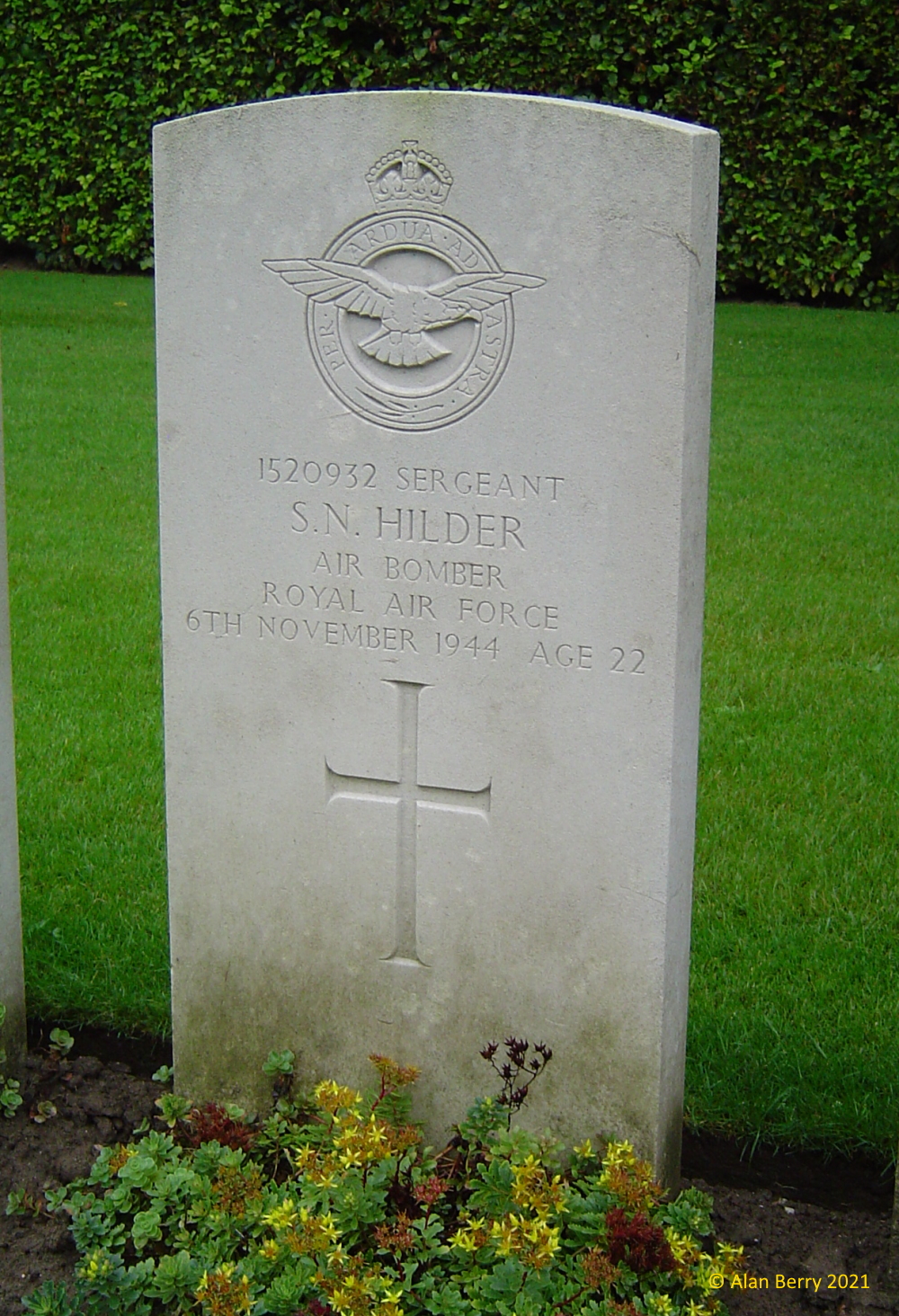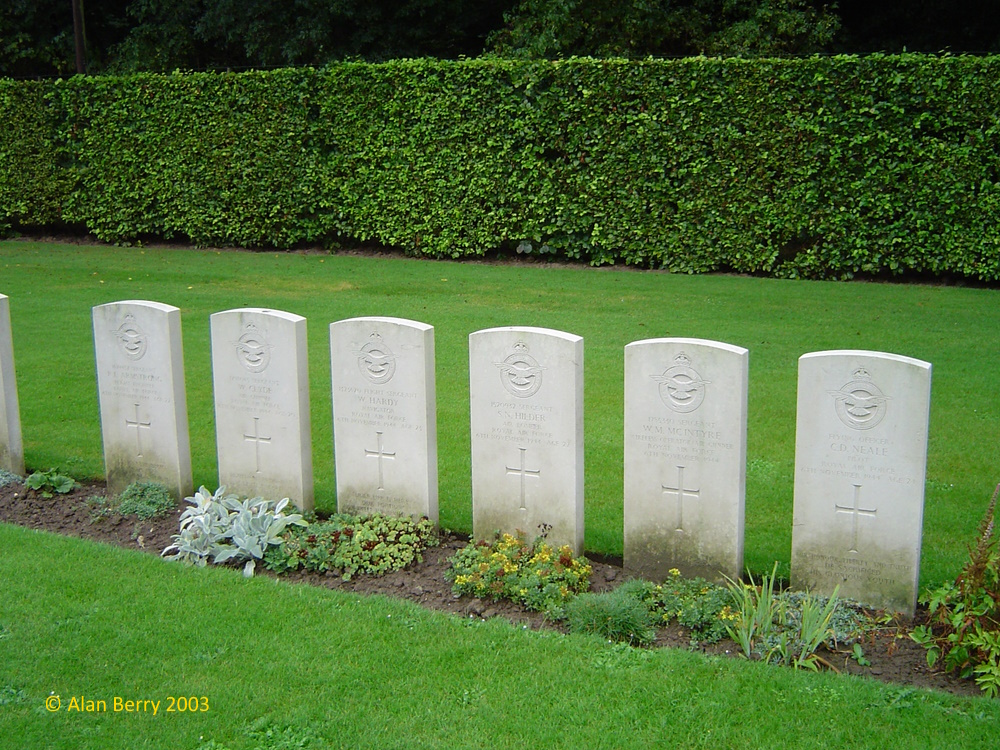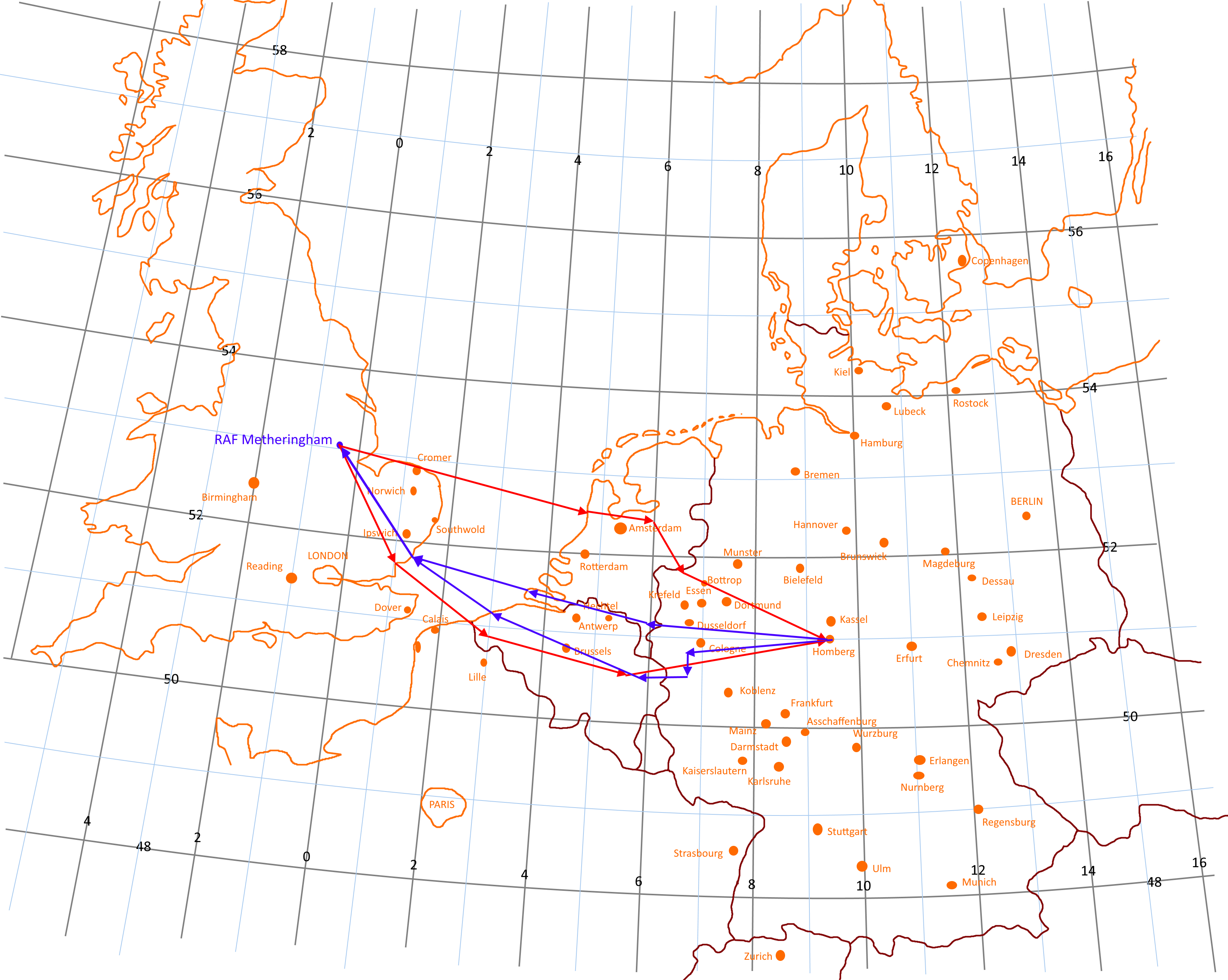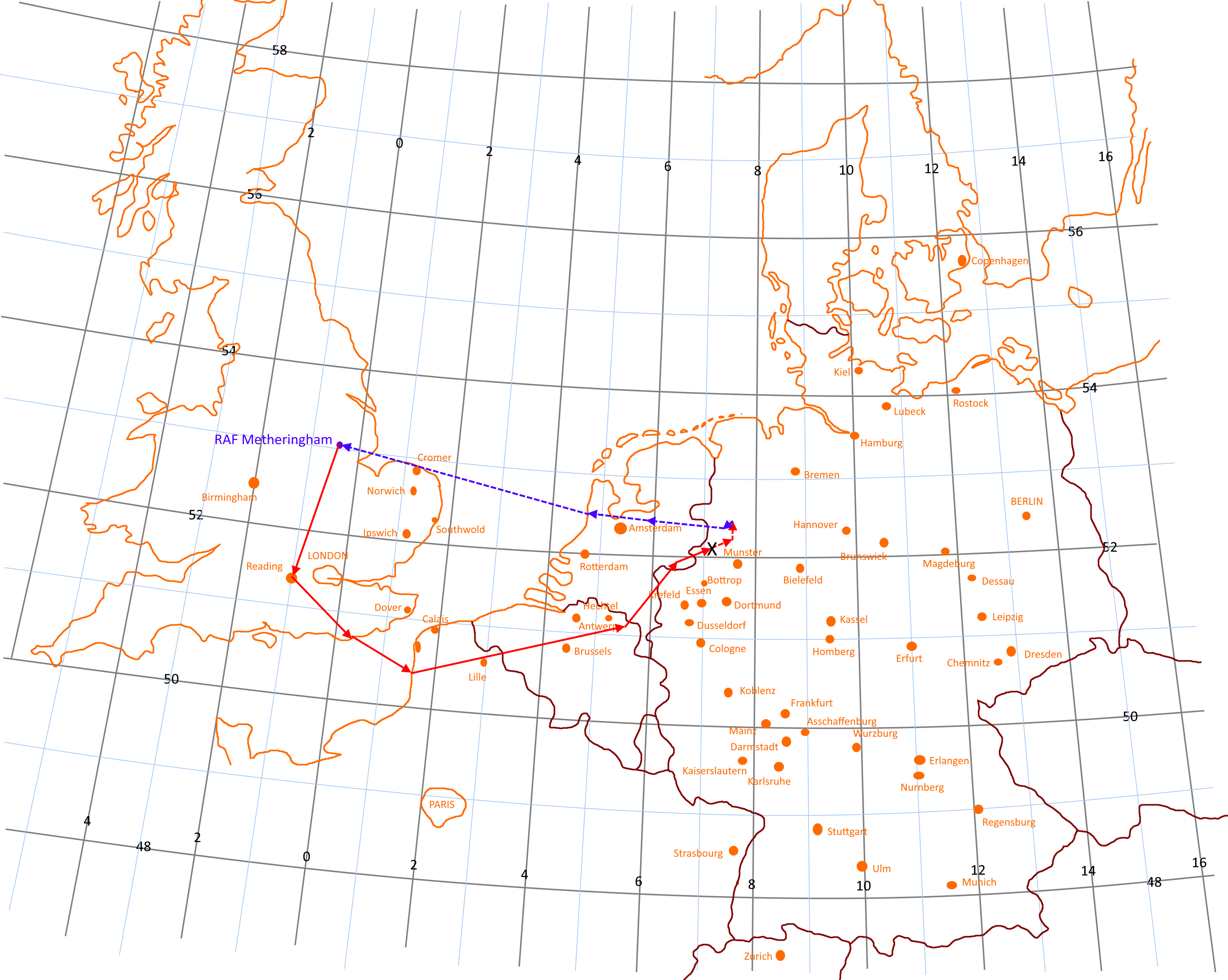THE VILLAGERS OF COLLINGHAM AND LINTON WHO SERVED IN WORLD WAR TWO
COLLINGHAMANDDISTRICTWARARCHIVE.INFO
 CONTACT
CONTACT





Rank Flight Sergeant
Service Number 1520932
Service RAF
Unit 106 Squadron
Regiment Royal Air Force
Killed in Action: 6th November 1944
Buried Reichswald Forest War Cemetery, Germany
- Lived in Collingham or Linton immediately prewar or during the war
(Usually taken from 1938 electoral roll or 1939 National Registration roll) - Listed on an illustrated list of Linton Parishoners who served
- Named on village war memorials
- Named in articles or lists in The Wetherby News or Collingham Parish Magazine
- Strong family connections with Collingham or Linton
- Address in 1939 or 1945/46: Linton-on-Wharfe
(taken from either the 1939 National Registration or the 1945 and/or 1946 service electoral rolls)
Biography
Family Background
Sydney Napier Hilder was born on the 19th January 1922 in Scotstoun, Glasgow, the elder son of George and Elizabeth Hilder. We do not know much about Sydney's early life or about his parents' lives in Scotland. Our first information about Sydney's connections with Collingham and Linton is that we find his mother, Elizabeth Hilder on the 1937 and 1939 electoral rolls living at 'The Shop, Linton'. There is no mention of Sydney's father on those rolls.
It is clear that Sydney Hilder was well known and played a full role in village life, as a leading member of Collingham and Linton Cricket Club. The March 1941 issue of the Collingham and Linton Parish magazine reports the 1st XI averages for the 1940 cricket season. The leading batsman was Sydney Hilder. He had batted 12 times in the season with 2 not-outs. His highest score was 103 not out, and he had scored a total of 340 runs at an average of 34.0. His brother Les was second in the averages (11 innings, 3 not out, highest score 45, with 210 runs at an average of 26.1. Both of the Hilders were also all-rounders. Sydney was fourth in the averages with 85 overs, 13 maidens, 19 wickets at a cost of 306 runs, average 16.1; while Les was third with 89 overs, 4 maidens, 23 wickets for 366 runs, average 15.0. Les had also taken 5 catches.
Service Record
Sydney Hilder enlisted for service on the 7th December 1941, as an Aircraftman 2nd Class at No. 3 Recruits Centre at RAF Padgate near Warrington. He was immediately placed in the reserve on the 8th, until he reported for duty on the 29th June 1942 at No 1 ACRC (Air Crew Reception Centre). Here Sydney would have been issued with uniform and his basic training along with aptitude tests and physical training would have started. After a month, Sydney was posted to No. 6 ITW (Initial Training Wing) based at the requisitioned Queen's Hotel Aberystwyth. Here Sydney is likely to have been assessed to see what roles in flight crew he was most suited for. At the end of his stay at 6ITW, on 16th October 1942, Sydney was promoted to Leading Aircraftman (LAC), and was posted via No 6 Air Crew Depatch Centre (6ACDC) to No 6 Elementary Flying Training School (6 EFTS). This appears to have been located at Sywell, Northamptonshire. At the end of this course, on 13th February 1943, some crew were selected for further training, and Sydney Hilder was posted to Canada for further training, arriving at 31 PD (Personnell Depot) in Moncton, New Brunswick, Canada on the 23rd February 1943.
No 31 Personnel Depot was a reception centre for members of the RAF moving to and from Canada and by the 30th March 1943, Sydney had moved to No. 34 Elementary Flying Training School (34 EFTS). This was a Second World War British Commonwealth Air Training Plan (BCATP) flying training station located near Assiniboia, Saskatchewan, Canada. It was operated and administered by the Royal Canadian Air Force (RCAF) and the Winnipeg Flying Club, operating as the Central Manitoba Flying Training School Ltd. who operated the school until No 34 EFTS was redesignated No. 25 EFTS on 30 January 1944. Crew were trained at 34 EFTS using the Cornell aircraft. By this time it is likely that Sydney's future role in the aircrew had been decided, and he went on to become an air bomber, commonly known as the bomb aimer, but with a role that also entailed knowing about air gunnery (in multi-engine aircraft such as the Lancaster the air bomber also operated the front guns) and air navigation to aid the navigator in finding the target.
Sydney's next posting, on the 12th June 1943, was to No. 31 Bombing and Air Gunnery School (31 BAGS) at Picton, Ontario, Canada, from where, after about 12 weeks, on the 18th September 1943 he was posted to No. 33 Air Navigation School (33 ANS) at Hamilton, Ontario, to learn to navigate by dead reckoning and visual methods using charts and compasses. That course saw the end of Sydney's crew training. On the 29th October 1943, Sydney was promoted to Temporary Sergeant and on the 2nd November he passed back through Moncton on his way home, arriving on the 2nd December 1943. On the 3rd he was formally posted to No 7 Personnel Reception Centre which was based in several requisitioned hotels in Harrogate Town Centre and which processed mostly aircrew returning from overseas during the Second World War (especially after training courses).
Men trained for air crew duties next had to learn about operating as part of an operational air crew and to form the close-knit crews that would work together on Squadrons. Sydney was posted for this part of his training to No. 14 Operational Training Unit on the 4th April 1944. At this stage of the war, No. 14 Operational Training Unit was based at RAF Market Harborough and was tasked with the training of crews for RAF Bomber Command in both daylight and night operations.
After OTU training Sydney's record show him at 51 Base RAF, which was at RAF Swinderby, and a mention is also made on his record of being at RAF Scampton. Finally on the 2nd September 1944, Sydney was posted to 106 Squadron at RAF Metheringham. RAF Metheringham was a Royal Air Force station situated between the villages of Metheringham and Martin about 12 miles south east of Lincoln. It had been constructed during 1942 and 1943, when approximately 600 acres of farmland and woods were cleared to create the new airfield for No. 5 Group RAF, Bomber Command. The station was planned as a Class A airfield standard layout and, although it was named Metheringham, was located largely in the adjoining parish of Martin. The runways were to the standard layout and specification with the main 02/20 runway at 2,000 yd long and with the 13/31 and 07/25 runways at 1,400 yd.
During the first few weeks on the squadron, Sydney, and the crew he was in, probably undertook training missions and it was not until the 27th September 1944 that they undertook their first operational mission.
First trip
Around this time, 106 squadron were chosen for a new role in Bomber Command. They would, from that point, only receive crews who had been recommended by their training units for employment in Pathfinder Squadrons. Those crew would complete their training, and carry out about five operational missions before proceeding to RAF Warboys for training in Pathfinder methods. After that they would return to 106 Squadron for further operational flying before being posted to either 83 or 97 Squadrons. Crews who were already with 106 Squadron were given the opportunity of volunteering for Pathfinder work, with those who did not volunteer being moved to other mainforce squadrons. In effect 106 Squadron was to become a Pathfinder nursery squadron.
Sydney Hilder must have volunteered for Pathfinder training as in October 1944 his record shows him spending 9 days at RAF Warboys. However that was still for the future, he first had to gain some more operational flying hours.
His second operational sortie came on the 5th October 1944 with the same crew, so Sgt Sime must have recovered from the wounding on the last mission.
Second trip
Sydney's second sortie was the above raid on Wilhelmshaven, and his next sortie followed immediately on the following day. This was a raid on Bremen.
Third trip
After a few days of bad weather where only local training flights were made, the Squadron started operational flying again around the 17th October, but Sydney and the rest of his crew did not take part. Instead, on the 21st October Sydney was sent to RAF Warboys, probably as part of the Pathfinder training mentioned above. According to his personal record, Sydney was promoted at this time to Temporary Flight Sergeant. He returned to RAF Metheringham and 106 Squadron on the 30th October and immediately the crew were rostered for a raid on the 1st November on Homberg.
Fourth trip
The raid on Homberg was a large raid with several flight routes being taken by the bombers. We think that Sydney and his crew flew the northerly route shown above.
The next couple of trips for 106 Squadron were attacks on the canal network in Germany. Sydney Hilder did not take part in the raid on the 4th November to attack the Ladbergen Embankment of the Dortmund-Ems Canal, but on the 6th, Sydney and the rest of Flying Officer Neale's crew did take part in a raid to attack the Mittelland Canal Embankment at Gravenhorst. These attacks were aimed at breaching canal banks and therefore draining the canals to prevent their use for transporting good and personnel for the German war effort.
Fifth trip
This raid on the Mittelland Canal was a very unsuccessful raid. It was aborted by the MasterBomber after the marking force of 235 Lancasters had difficulties in identifying the target for the 235 Lancasters taking part. Of the 7 Mosquito markers engaged only one was able to indicate the target from a very low height but the marker fell into the canal itself extinguishing it and this combination of events deprived the main force of accurate marking. At this point the Master Bomber called off the operation with only 31 aircraft able to bomb. The disasters of the night were further compounded for Bomber Command who lost 10 Lancasters and a 214 Squadron Fortress from No 100 Electronic Counter Measures Group. The marking difficulties were followed by a short intense battle lasting about 20 minutes which took place as the bomber force approached the target and as they started to return home.
Sydney Hilder's aircraft was one of those shot down and all the crew were lost. The crew were initially buried at Nienborg (shown with an X on the above map). The Germans were only able to identify the rear gunner, Sgt Croll, presumably as he may still have been in the rear turret, but the rest of the crew were buried in a communal grave. After the war, in 1947, the Commonwealth War Grave Commission (CWGC) carried out a concentration of buried Allied service men into a number of larger cemeteries. At that time the bodies of the crew were exhumed and the CWGC were able to individually identify the bodies. The crew are now buried in the Reichswald Forest War Cemetery.

The members of the crew who died are buried together in the Reichswald War Cemetery.
182745 Flying Officer Conrad Denis Neale, aged 24, of Bedworth, Warwickshire
1674487 Sgt Robert Lionel Armstrong, aged 22, of Gilsland, Cumberland
1323620 Flight Sergeant Walter Hardy, aged 23, married, of Wanstead, Essex
1520932 Sgt Sydney Napier Hilder
1785330 Sgt William Meikle McIntyre
1798065 Sgt William Clyde, aged 20, of Bushmills, Co Antrim
1825884 Sgt James MacGregor Croll, aged 21, of Greenock, Renfrewshire
Sydney's brother, William Leslie Hilder, also died on RAF operations in World War 2 and his service is detailed here.
Biography last updated 08 August 2023 13:34:37.
If you have any photographs or further details about this person we would be pleased to hear from you. Please contact us via: alan.berry@collinghamanddistrictwararchive.info



